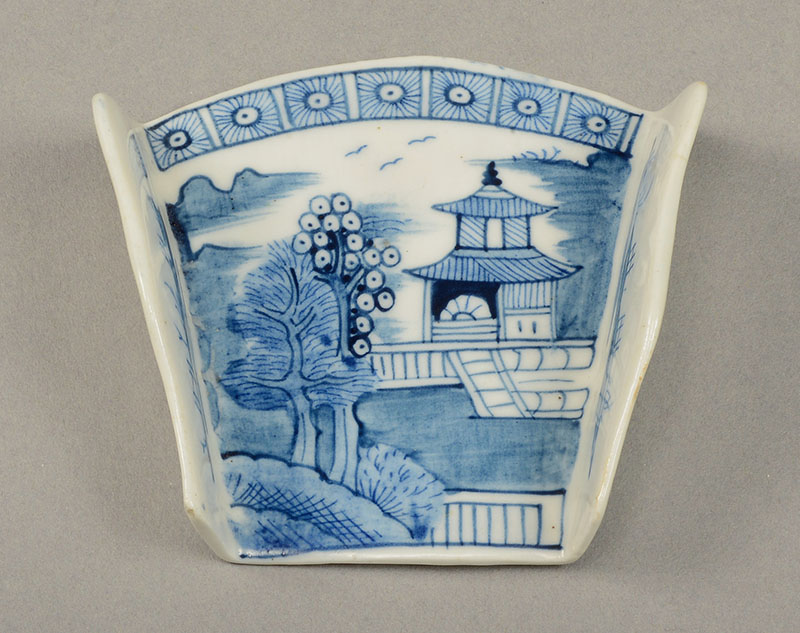A Summer Immersed in American History and Decorative Arts
by Tanyi Tseung
Supported by a Continuing Education Scholarship from the Decorative Arts Trust, I participated in Historic Deerfield’s Summer Fellowship Program in 2024. I forged valuable connections with mentors and peers and enriched my understanding of museum work and material culture. For my capstone research project, I investigated the 1910 film Ononko’s Vow: A Colonial Tale, focusing on how it reconstructs indigenous-settler encounters in Deerfield, MA. My study reveals how Colonial Revival filmmakers and audiences, grappling with anxieties about industrialization and immigration, crafted an idealized narrative of their English ancestors and the Native American peoples they encountered.
I also conducted an in-depth object study of a porcelain asparagus server (figure 1) in Historic Deerfield’s collection. I explored how the Western imagination of China in material culture intersected with emerging patterns of conspicuous consumption in British high society in the 18th century. This research experience has deepened my interest in Orientalism and chinoiserie in European and American visual and material culture, a field I plan to further explore during my senior year at Yale University as well as in graduate studies and beyond.
This delicate, fan-shaped asparagus server was produced c. 1775 by the Derby Factory (1748–1848) in central England. Derby was one of the many porcelain factories in England and Continental Europe to produce imitations of coveted Chinese porcelains. The object’s underglaze cobalt blue decoration depicts a chinoiserie landscape that would have resonated with contemporary European viewers: Scenic trees and mountains decorate the left side of the composition, conveying a yearning for innocent and idyllic nature. On the right side, stairways lead to a pagoda, inviting the viewer to step into the Buddhist structure for contemplation and moral cultivation. The China on this object is a land of European invention that idealized “Cathay” as a pastoral, picturesque, and dreamlike world. Inaccessibility to Chinese culture and real Chinese landscape due to trade restrictions might have facilitated this romanticization in Western culture. When this asparagus shell was made and used in the 1770s, British admiration for China was so profound that owning such Chinese-style objects offered a sense of cultural legitimacy and a connection to an esteemed past.
China’s antiquity and isolationism helped make Chinese objects desirable and also played a role in promoting the aspirations of the British upper class. In the 17th and 18th centuries, meals followed a French style of multiple courses, with desserts of fruit and jams. Servants carefully arranged dishes symmetrically around the table, with diners serving themselves from the closest dishes. Asparagus, a prized spring vegetable, was served on such elegant dishes to reflect both the exoticism of the food and the prestige of the porcelain. This chinoiserie asparagus shell reproduced, on a miniature scale, 18th-century British high society’s aesthetic interests in China and their inclination to display wealth through objects. What is particularly intriguing is how readily 18th-century British consumers aligned their socio-economic identity with the prestige and antiquity of a civilization they would come to dismiss. In the mid-19th century, as Britain sought to open China for trade, they labeled it a stubborn, backward nation resistant to adopting Western ways and ideas.
As I enter the final year of my undergraduate studies, I plan to continue exploring the links between capitalism, consumerism, and Orientalism in Western decorative arts. After graduation, I aim to gain work experience in arts and cultural institutions to inform my decision on whether to pursue a Master’s Degree in Material Culture or a PhD in History and Art History. My long-term goal is to become a museum curator and historian, where I hope to advocate for historically marginalized communities and illuminate our shared history. The Historic Deerfield Summer Fellowship program has forever enriched me as a student, scholar, and historian, and I am grateful for the Decorative Arts Trust’s support in making this possible.
Tanyi Tseung is pursuing her B.A. in History and East Asian Studies at Yale University.
About The Decorative Arts Trust Bulletin
Formerly known as the "blog,” the Bulletin features new research and scholarship, travelogues, book reviews, and museum and gallery exhibitions. The Bulletin complements The Magazine of the Decorative Arts Trust, our biannual members publication.
Click Images to Enlarge
Did you know that clicking on the images in Bulletin posts will allow you to get a closer look? Simply click on an image, and a larger version will open in a pop-up window.










